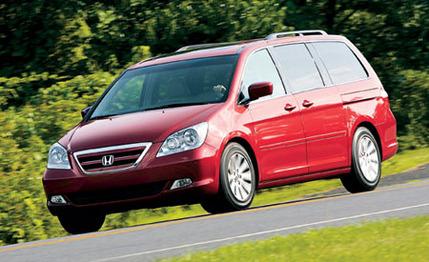 First Drive Review
First Drive Review
With the third-generation Odyssey, Honda set out to build what it imaginatively refers to as not just a really nice minivan but a "Premium Adventure Vehicle." This is in keeping with the name of the company's next lawn mower, the "Ultimate Grass Guillotine."
Okay, we made up the mower gag, but we can't take credit for the minivan hyperbole, which is the Honda marketing gang's way of saying the Odyssey offers exceptional style, performance, utility, and-why not throw this in too?-appeal to the budding number of young Gen-X and Gen-Y families. Honda must know that these generations love acronyms, because the Odyssey has accrued more than a pharmacy shelf.
Headlining the alphabet trios is VCM, or Variable Cylinder Management, a new system that automatically shuts off three of the Odyssey's six cylinders when there's no need for a lot of power, say, when cruising on the highway. When VCM-incorporated into the i-VTEC version of the Odyssey's 3.5-liter V-6 (there's also a standard VTEC version)-decides to switch to three-cylinder mode, a pin that joins the valve lifter to the rocker arm moves and disengages the two parts, allowing the lifter to freewheel without moving the rocker arm; thus, the valves stay closed. The result is the same horsepower as the non-VCM six, but with better estimated fuel economy (20/28 versus 19/25).
The Odyssey carries another ace in the hole, as in ACE, short for Advanced Compatibility Engineering. ACE produces a structure that is 20 percent stiffer in both torsional and bending rigidity and that, according to Honda, improves the Odyssey's ability to cushion impacts. Speaking of cushion, safety inflatables include dual-stage front airbags, driver and front-passenger side airbags, and three-row curtain airbags.
In the styling department, the Odyssey has evolved into a much more striking van. Sheetmetal now appears shrink-wrapped-indeed, panel gaps have been reduced by up to 1.5 millimeters-giving the Odyssey an athletic stance that is emphasized by a tauter rear end and a sportier front fascia with dual projector-beam headlights. Dimensionally, it's 1.5 inches wider, about the same in length, and 0.3 inch taller. Yet it looks shorter and sleeker, despite a roofline closer to the clouds. Oh, the magic of a wider body on an identical 118.1-inch wheelbase.
For third-row passengers, there are three more inches of legroom, although the cargo area behind the last row remains at 38 cubic feet. The much-copied fold-into-the-floor third-row Magic Seat is now split 60/40 and features one-hand operation and integrated headrests. The second-row captain's chairs can't be folded into the floor à la Dodge Caravan's Stow 'n Go, but they are removable (a relatively easy operation of flipping a couple of latches and lifting what feels like a medium-sized ahi tuna). They can also slide fore-and-aft 10 inches and can be positioned bench style or separated to make room for the new PlusOne seat (on EX models). The wee PlusOne functions as an eighth seat or, with the backrest folded forward, as a console replete with a storage tray. It stows in the floor between the first and second rows in a new in-floor storage area, which, if not holding the PlusOne, houses a rotating lazy-Susan storage unit.
Inside, the Odyssey impresses with an upscale interior comprised of first-rate materials, fit and finish, and ergonomics. The driver is greeted by a tasteful two-tone dashboard with attractive metallic trim, a shifter moved up to the dashboard, and a straightforward instrument cluster with progressive meter illumination. This level of sophistication is easy to appreciate given the lack of noise in the cabin. With a coefficient of drag reduced by about five percent and enough advanced sound-absorbing material to turn a condo into a recording studio, the Odyssey is a mobile room of serenity.
The one downside to all the sound deadening is that it's difficult to hear the melodic 3.5-liter VTEC V-6 as it works to transport your noisy little monsters to soccer practice. Teamed with a five-speed automatic, the 24-valve engine now makes 255 horsepower and 250 pound-feet of torque-an increase of 15 horses and 8 pound-feet-and is conducted by a linear drive-by-wire throttle. The two top trim levels get VCM, which the driver will be unaware is diligently at work, thanks to two electronically controlled engine mounts on either side of the transverse engine. These mounts have a solenoid that can vibrate at a frequency 180 degrees out of phase with the engine's vibes, thus ensuring that no unruliness reaches the cockpit. There's also the active noise control system that emits "anti-noise" via the speakers.
The Odyssey continues to ride on struts up front and a multilink setup in the rear, and the latter have been hooked to a rubber-mounted subframe said to improve isolation. Now standard are Vehicle Stability Assist (VSA) with traction control, 16-inch wheels with 235/65 tires, and twin-piston front brake calipers.
The Odyssey menu consists of four choices. The base LX gets anti-lock brakes, second-row power windows, cruise control, and a CD player. Stepping up to the mid-level EX adds alloys, power sliding doors, and a six-CD in-dash changer. The EX with Leather has VCM and optional navigation and DVD systems. For the ultimate in minivan magnificence, there's the new Touring trim. It, too, gets VCM and then goes nuts with a power tailgate, trizone automatic climate control, a 115-volt power outlet, power-adjustable pedals, and Michelin's PAX System tire-pressure monitor.
The new Odyssey still doesn't offer four-wheel drive, but otherwise, this is an impressive upgrade of an already strong vehicle.